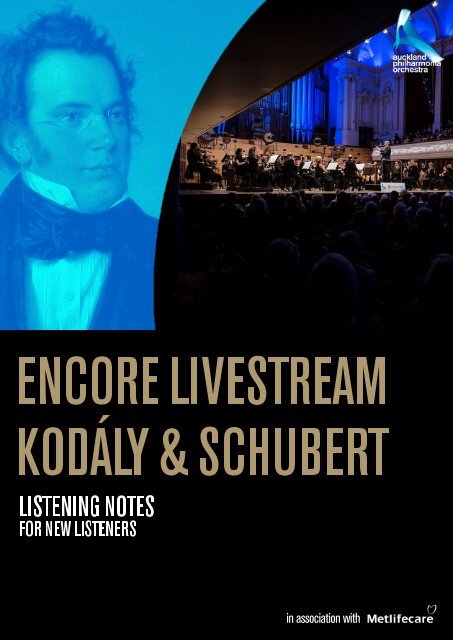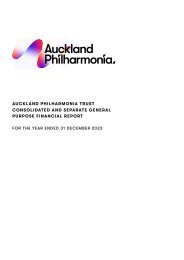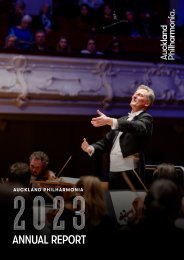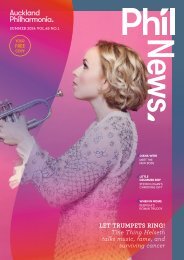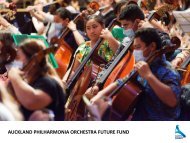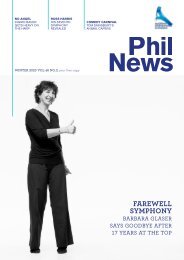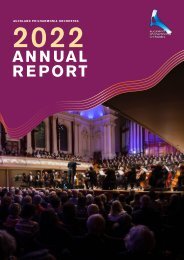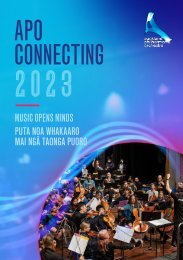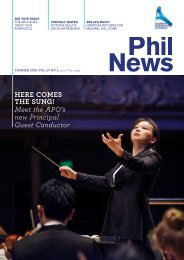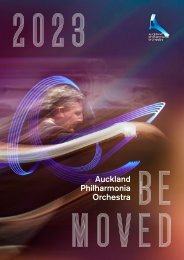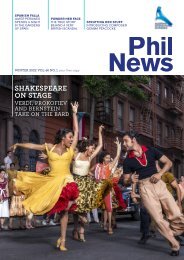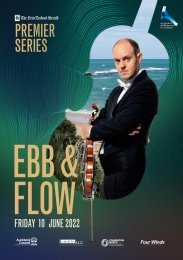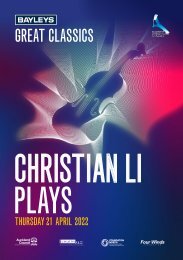Create successful ePaper yourself
Turn your PDF publications into a flip-book with our unique Google optimized e-Paper software.
ENCORELIVESTREAM<br />
KODÁLY&SCHUBERT<br />
LISTENINGNOTES<br />
FORNEWLISTENERS<br />
inasociationwith
ZOLTÁN KODÁLY<br />
(1882 – 1967)<br />
COMPOSER PROFILE<br />
• Hungarian composer, ethnomusicologist, music<br />
educator and linguist<br />
• Played a prominent role in Hungarian public life,<br />
held several public posts and was a member or<br />
head of numerous boards and committees<br />
• Much of the music he composed was based on folksongs<br />
he collected on his travels around Hungary<br />
• He formed the ethnomusicological branch of the<br />
Hungarian Academy of Arts and Sciences<br />
THE DANCES OF GALÁNTA<br />
Inspired by his pleasant childhood experiences,<br />
Kodály returned to Galánta as an adult in 1905 and<br />
transcribed at least 150 melodies from the region.<br />
These songs, together with an album of old Hungarian<br />
folk music that was compiled in the 1800s, comprise the<br />
main source material for the Dances of Galánta. They<br />
were written as a follow-up to the successful Dances<br />
of Marosszék of a year before, which were composed<br />
initially for piano and then orchestrated.<br />
On one level, the Dances of Galánta are a medley<br />
of folk tunes, skilfully wrought into a suite lasting<br />
around 15 minutes, making it the perfect filler<br />
for a typical concert programme. On another,<br />
more symbolic level, they form a unified musical<br />
celebration of the resurgence of a Hungarian<br />
nation after years of Austrian oppression.<br />
The Dances of Galánta unfolds in five sections,<br />
typically lasting about fifteen minutes.<br />
As a device to build tension, the violins often play<br />
busy stepwise fast notes over a sustained note.<br />
As with any folk music, there is much repetition of<br />
melodic and rhythmic ideas, and the main solos are<br />
given to the violin or clarinet/tárogató.<br />
DID YOU KNOW?<br />
A typical Google search for ‘Kodály’ will yield the<br />
top results for him as an educator, not a composer.<br />
He is often referred to as the most important and<br />
influential music educationalist of the 20th century.<br />
OTHER FOLK INSPIRED MUSIC<br />
YOU MIGHT ENJOY:<br />
Aaron Copland excerpts from Rodeo (Western folk tunes)<br />
Frederic Chopin various mazurkas (Polish folk dances)<br />
Bela Bartok Three Rondos or excerpts from 15 Hungarian<br />
Peasant Songs<br />
A common misunderstanding is to attribute Kodály<br />
with the creation of the hand signs that accompany<br />
pitch and singing.<br />
These signs were actually developed by John<br />
Curwen, a British priest and music educator. Kodály<br />
made use of them along with other physicalisations<br />
of musical language to help young children<br />
understand pitch and embody rhythm.<br />
2
FRANZ<br />
SCHUBERT<br />
(1797 – 1828)<br />
COMPOSER PROFILE<br />
• An Austrian composer from the Romantic period<br />
• Won a place in the Vienna Imperial Court chapel choir<br />
at age 10<br />
• After leaving school in 1815, <strong>Schubert</strong> followed his<br />
father into teaching. He did not enjoy this job, and he<br />
spent all of his free time composing.<br />
• The same year he started teaching, he wrote his<br />
famous ‘Gretchen am Spinnrade’ (‘Gretchen at her<br />
spinning wheel’)<br />
• He composed 145 lieder (songs), his Second and Third<br />
Symphonies, two sonatas and a series of miniatures for<br />
solo piano, two mass settings and other shorter choral<br />
works, four stage works, and a string quartet<br />
• The only public concert <strong>Schubert</strong> gave was on<br />
26 March, 1828. It was such an artistic and financial<br />
success that <strong>Schubert</strong> at last purchased a piano<br />
• He died in 1828 at age 31, of typhoid from drinking<br />
tainted water<br />
SYMPHONY NO.9 ‘THE GREAT’<br />
A symphony is a musical composition for full orchestra;<br />
typically in four movements or sections.<br />
The title ‘The Great’ was applied by a 19th-century<br />
publisher to distinguish between this symphony and<br />
<strong>Schubert</strong>’s earlier work of 1818. Today, ‘The Great’ has<br />
become an accepted part of the work’s title. <strong>Schubert</strong>’s<br />
Ninth Symphony has four movements:<br />
I. Andante<br />
II. Andante con moto<br />
III. Scherzo (Allegro vivace)<br />
IV. Allegro vivace<br />
The first movement, Andante (At an easy walking pace,<br />
Allegro – fast) starts with a theme from the horns. This is<br />
followed by the strings playing a rhythmic triple figure. The<br />
theme is then passed around the orchestra. The section<br />
continues to explore themes and assembled rhythmic<br />
material.<br />
Finally, as the Andante moves towards its close, you can<br />
hear a fragment of what is to become the Allegro section’s<br />
theme. As the Andante is brought to a full orchestral close,<br />
the Allegro (fast) section follows immediately. Strings,<br />
trumpets, and timpani introduce the Allegro’s first theme.<br />
<strong>Schubert</strong> introduces a second theme – rising and falling,<br />
with the woodwinds and horns playing a triple rhythm.<br />
Finally, the movement’s third theme is introduced by oboes<br />
and bassoons, accompanied by violin.<br />
The final section is marked ‘Piu Moto’ (more movement).<br />
It starts with the second theme in the strings, with an<br />
accompanying triple figure. The movement ends with the<br />
introductory horn theme played by the full orchestra.<br />
The second movement, Andante con moto (At an easy<br />
walking pace with motion) is slow, however the ‘con moto’<br />
direction creates a march-like character. It is possible that<br />
<strong>Schubert</strong> was influenced by the Allegretto movement of<br />
Beethoven’s Seventh Symphony.<br />
This movement has four sections and four main themes.<br />
The oboes play the theme first, followed by the clarinets,<br />
violins, and violas, moving to an orchestral climax. Next,<br />
the oboes and clarinets enter with the second theme. This<br />
theme is slightly slower, and the strings break in with a<br />
third theme, with a military feel.<br />
The second and third themes are developed, and the<br />
lower strings introduce the fourth theme. Lyrical and more<br />
sonorous, this theme is played by the bassoons, second<br />
violins and basses. The movement ends quietly, with<br />
harmony from the three trombones.<br />
3
The third movement, Scherzo (Allegro vivace, playful,<br />
light and very fast) opens with the first theme played by<br />
the strings. A second feature of the movement is the<br />
waltz themes that keep appearing – the first of these<br />
constitutes the second theme.<br />
The second section opens in the woodwinds and brass,<br />
with a short, detached string accompaniment. This section<br />
ends with two loud chords. The Trio section then starts<br />
with horns, clarinets, bassoons, and trumpets playing<br />
together and the movement’s fourth theme is played by<br />
a woodwind choir. Next, the flutes and bassoons play the<br />
Trio’s opening theme again. The Trio then repeats back to<br />
the start of the Scherzo to finish that movement.<br />
The final movement, Allegro vivace (very fast), has two<br />
main themes. It begins with a call to attention, with very<br />
loud notes. The second theme also has a running rhythm<br />
in the strings while the woodwinds play the melody.<br />
There are fragments of this theme until both main<br />
themes are heard again in their entirety.<br />
A final section expands some of the melodic material<br />
with a short episode where strings, horns and bassoons<br />
play with the full orchestra answering in different keys.<br />
The final section is unusually long and the movement’s<br />
introductory rhythm returns before a very sudden, loud<br />
chord that gradually fades away to the end.<br />
DID YOU KNOW?<br />
In March 1827, <strong>Schubert</strong> was a torchbearer at<br />
Beethoven’s funeral.<br />
4
WHAT’S THE<br />
NEED FOR SPEED?<br />
IN MUSIC, WE USE ITALIAN NAMES TO TELL US HOW FAST,<br />
OR SLOW, TO PLAY. THIS IS CALLED THE TEMPO.<br />
Here are some of those names – or tempo<br />
markings – used in classical music:<br />
SLOWER<br />
FASTER<br />
LARGO<br />
(40-60 BPM)<br />
ADAGIO<br />
(66-76 BPM)<br />
ADANTE<br />
(76-108 BPM)<br />
ALLEGRO<br />
(120-168 BPM)<br />
VIVACE<br />
(168-176 BPM)<br />
PRESTO<br />
(168-200 BPM)<br />
You will notice that there is a number after each tempo and<br />
the letters BPM. This stands for Beats Per Minute. You<br />
can use the second hand of a clock, or a watch, to roughly<br />
work out how fast the speeds are.<br />
60 BPM is 60 beats per minute – or one beat per second.<br />
Allegro is 120 beats per minute – or two beats per second.<br />
Presto is around three beats per second.<br />
And so on!<br />
Look at the tempo markings for the Violin Concerto, or<br />
Symphony No.9 and see if you can tap your foot in time<br />
with the tempo for each piece.<br />
5


